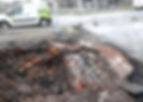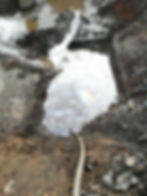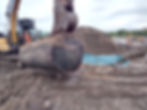An East Side Story...
- ERS Remediation
- Jul 22
- 4 min read

Glasgow’s East End was once home to a large area of derelict land, earmarked as a redevelopment area but left vacant for many decades. It was made up of several adjacent brownfield sites – formerly an abattoir/meat market, a timber yard, a vehicle repair garage and a filling station. ERS has been involved in multiple phases of works across this redevelopment area, covering its journey from an overlooked site, known to be contaminated, through several phases of building works to the regenerated community it is today.
ERS' involvement starting in 2015 when we did a large site investigation, followed by a phyto/bioremediation feasibility study for Glasgow City Council. A desktop study had suggested a low risk of anthrax due to the presence animal processing waste in the former meat market area, so cryobiological analysis was undertaken in advance of the main works.

As well as cow parts, the site investigation identified several areas of localised asbestos, hydrocarbons and heavy metals contamination across the sites, associated with their former uses. In addition, historical records had indicated the presence of several underground storage tanks located across multiple sites. Some of these tanks had leaked causing localised hydrocarbon contamination.
Using the site investigation findings, the feasibility study concluded that neither phytoremediation nor bioremediation would be suitable for these sites due to the ground conditions and the nature of some of the contaminants. Following this, plans for the area were put on hold and the land was left derelict for several years.
Jump forward to 2021 and regeneration plans for the area were finally in place with developers showing interest and even construction works underway in non-contaminated locations. ERS became involved once more, carrying out sampling for a regular contractor client at one site whilst carrying out an intrusive ground investigation for a consultant client in another site.

Both jobs were looking for the presence of underground tanks and associated hotspots of hydrocarbon contamination. ERS was asked to do a project extension on one of the sites to delineate the extent of the contamination around one of the tanks.
Later in the year, ERS carried out tank pulls, hydrocarbon contamination hotspot remediation and verification on one of the sites for a housebuilder involved in the regeneration scheme. ERS exposed the tanks, pumped out any remaining contents (which were disposed of at a suitably licenced facility) and removed the tanks from the ground. The tanks were then cleaned inside and out and a de-gas certificate was provided to allow them to be removed off-site for recycling.

Later during the building works, an unexpected fuel tank not shown on historical site records was uncovered. The tank was filled with oily water, which we pumped out into one of our oil/water separators. It was then cleaned, certified as gas-free and removed for recycling along with the other tanks.
ERS also carried out further intrusive ground investigation works for the consultant client looking for the presence of foundations for some of the buildings that had previously been on the site.

The following year, works started on remediating soil and groundwater affected by hydrocarbons in 10 hotspots across the site close where the leaking tanks had been. One hotspot was also affected by suspected coal tar. ERS excavated the impacted soils, which were then removed to a suitable site for disposal. Oily water that was exposed by the excavation was skim-pumped out into a temporary storage tank. Verification samples were collected and excavations extended where exceedances were noted.


During the excavation of one hotspot, another unexpected tank was discovered, lying neatly in-between previously excavated locations. The tank was found to be full of oily water which needed pumping out. There were strong visual and olfactory observations of black oil contamination in the clayey ground surrounding the tank. This all needed to be excavated for disposal. The tank was then washed, degassed and certified and sent for recycling.

Then during utility infrastructure works for new houses in another part of the site, yet another unexpected UST not on any historical records was discovered. The client asked ERS to remove the tank and remediate any impacted contaminated soils. This tank was also full with water. ERS removed the water from the tank, and it was excavated and processed for recycling. The soils surrounding the tank were removed down to the concrete sump. As no contamination was present beneath the slab and excavating it could risk the newly completed housing structures and utilities, it was decided to leave it in situ.

ERS’ final involvement at the site was a small project doing some soil sampling for a regular client who was involved in a later phase of the building works in 2023. By this stage, many of the houses in the masterplan had been completed and were already occupied by local families.
Today, after various site investigation and remediation works by ERS on behalf of many clients, several phases of housebuilding works by multiple contactors and a lot of tanks popping up in strange locations, this once forgotten part of Glasgow is now thriving and home to hundreds of families living in modern, energy efficient homes – many of them affordable homes run by local housing associations.

📷 from Wheatley Homes' press release
For a couple of years “Not another tank!” became part of everyday life at ERS as teams scrambled to assist our clients with their removal and hotspot remediation, and get the building works back on track. Working on this incredible site has allowed the staff involved to broaden their brownfield remediation knowledge and experience.
However, it is of course but one short phase in the long history of this part of Glasgow’s East End, with an exciting future still to come now the area has been regenerated.


